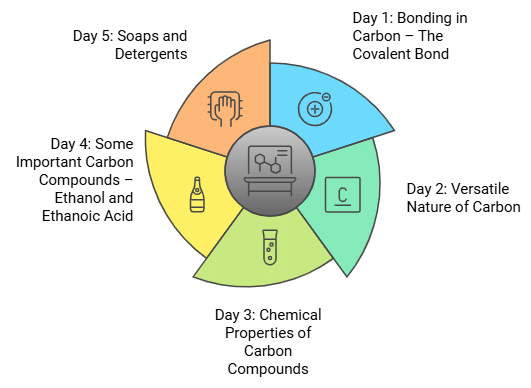5 Days Timetable: Carbon and its compounds | Science Class 10 PDF Download
The chapter on "Carbon and its Compounds" is a crucial part of the Class 10 Science syllabus, and it holds significant importance in your board exams. This chapter explores the fascinating world of carbon compounds, their structures, properties, and applications. It's essential to master this chapter as it forms the foundation for more advanced topics in chemistry.
This study plan is designed to cover all the key topics in this chapter efficiently. You can adjust the timetable according to your pace, but the order of topics should remain the same. Additionally, always remember to refer to the NCERT textbook for in-depth understanding and practice.
Topics to Cover
Before diving into the study plan, let's list the topics we need to cover in this chapter:

Day 1: Bonding in Carbon – The Covalent Bond
- Start by reading the corresponding chapter from your NCERT textbook.
- Watch the video lessons on Carbon and its Compounds on EduRev to gain a conceptual understanding.
- Go through the Chapter Notes for a summary.
- Solve the Practice Questions to test your knowledge.
- Use the Mindmap as a visual aid to reinforce concepts.
Study Tip: Understand the concept of covalent bonding thoroughly as it forms the basis of organic chemistry.
Day 2: Versatile Nature of Carbon
- Review the previous day's content.
- Explore the versatile nature of carbon compounds by reading the NCERT textbook.
- Use Lakhmir Singh & Manjit Kaur Solutions on EduRev for additional practice.
- Solve Short & Long Questions & Answers to test your knowledge.
Study Tip: Pay close attention to the different forms of carbon compounds and their properties.
Day 3: Chemical Properties of Carbon Compounds
- Revise the concepts learned so far.
- Study the chemical properties of carbon compounds from your NCERT textbook.
- Practice with NCERT Solutions to understand how to solve textbook questions.
- Test yourself with Assertion & Reason Type Questions for critical thinking.
Study Tip: Focus on the reactions and properties of various carbon compounds.
Day 4: Some Important Carbon Compounds – Ethanol and Ethanoic Acid
- Recap the previous topics.
- Dive into the specifics of ethanol and ethanoic acid in your NCERT textbook.
- Practice with NCERT Exemplar questions for a deeper understanding.
- Explore the PPT - Carbon and its Compounds for visual aids.
Study Tip: Understand the structures, properties, and uses of ethanol and ethanoic acid.
Day 5: Soaps and Detergents
- Review the previous topics.
- Study the formation and properties of soaps and detergents in your NCERT textbook.
- Practice solving Case Based Questions to apply your knowledge in real-life scenarios.
- Challenge yourself with HOTS Questions to enhance your critical thinking skills.
Study Tip: Understand the difference between soaps and detergents and their applications.
Revision and Self-Testing
- Use this day solely for revision.
- Revisit the concepts and notes from each topic.
- Test yourself by solving questions from various categories:
Study Tip: Test yourself comprehensively to identify areas that need further review.
Here are all the important links and topic links for the chapter "Carbon and its Compounds" at the end:
Important Links:
- Class 10 Boards (For overall Class 10 board exam resources)
- Past Year Questions (For practicing previous year board exam questions)
- Chapter (For video lessons, documents, and MCQs related to the chapter)
- Chapter Notes (For summarized notes on the chapter)
- NCERT Textbook (For referring to the official textbook)
- NCERT Solutions (For solutions to NCERT textbook questions)
- Short & Long Questions & Answers (For additional questions and answers)
- Assertion & Reason Type Questions (For critical thinking questions)
- Mindmap (Visual aids for better understanding)
- Lakhmir Singh & Manjit Kaur Solutions (For additional practice)
- NCERT Exemplar (For more challenging questions)
- PPT - Carbon and its Compounds (For visual presentations)
- Practice Questions (For additional practice questions)
- HOTS Questions (For higher-order thinking questions)
- Case Based Questions (For scenario-based questions)
- Very Short Answer Type Questions (For quick practice)
- Short Answer Type Questions (For practice with shorter responses)
- Long Answer Type Questions (For in-depth practice)
Topic Links:
- Bonding in Carbon – The Covalent Bond
- Versatile Nature of Carbon
- Chemical Properties of Carbon Compounds
- Some Important Carbon Compounds – Ethanol and Ethanoic Acid
- Soaps and Detergents
Remember, it's essential to maintain a balanced study schedule for all your subjects. You can find timetables for your other subjects on the Class 10 Boards page on EduRev.
Good luck with your preparations!
|
80 videos|569 docs|80 tests
|
FAQs on 5 Days Timetable: Carbon and its compounds - Science Class 10
| 1. What is a covalent bond and how does it form in carbon compounds? |  |
| 2. Why is carbon considered a versatile element in chemistry? |  |
| 3. What are the main chemical properties of carbon compounds? |  |
| 4. What are the uses and properties of ethanol and ethanoic acid? |  |
| 5. What is the difference between soaps and detergents? |  |






















